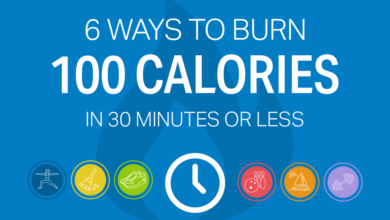
Mental Tricks to Get Through Tough Workouts
Mental tricks to get through tough workouts are like secret weapons in your fitness arsenal. They can transform your workouts from grueling battles to empowering journeys. Whether you’re facing a plateau, battling fatigue, or simply seeking that extra push, these mental strategies can help you conquer your fitness goals.
This guide will explore a variety of mental techniques that can help you stay motivated, focused, and resilient during even the most challenging workouts. From the power of positive self-talk to the art of visualization, we’ll delve into strategies that can help you overcome mental barriers and unlock your full potential.
Pain Management
Pain is a common experience during workouts, but it’s important to differentiate between pain signals and discomfort. Discomfort is a normal sensation that indicates your muscles are working hard, while pain signals a potential injury.
Differentiating Between Pain and Discomfort
Understanding the difference between pain and discomfort is crucial for safe and effective training. Discomfort is a natural feeling during exercise, indicating that your muscles are being challenged and adapting. It’s often described as a burning sensation or muscle fatigue.
Pain, on the other hand, is a sharp, stabbing, or shooting sensation that may indicate an injury. It’s usually accompanied by swelling, redness, or difficulty moving the affected area.
Managing Pain During Workouts
Managing pain during workouts can be achieved through various techniques, including:
- Breathing Exercises:Deep, controlled breathing can help regulate your heart rate and reduce tension in your muscles. Try inhaling deeply through your nose, holding your breath for a few seconds, and exhaling slowly through your mouth.
- Muscle Relaxation Techniques:Progressive muscle relaxation involves tensing and then relaxing different muscle groups, helping to reduce overall muscle tension. You can also try visualization techniques, focusing on relaxing images or sensations.
- Proper Warm-Up and Cool-Down:A proper warm-up prepares your body for exercise, increasing blood flow to your muscles and reducing the risk of injury. A cool-down helps your body gradually recover, reducing muscle soreness and stiffness.
- Hydration:Dehydration can contribute to muscle cramps and pain. Make sure to drink plenty of water before, during, and after your workout.
Proper Form and Technique
Proper form and technique are essential for reducing pain and preventing injuries during workouts. Using correct form ensures that the right muscles are being engaged and that the load is distributed evenly. Incorrect form can put unnecessary stress on your joints and muscles, leading to pain and injury.
“Form is everything. If you don’t have the proper form, you’re not going to get the results you want, and you’re more likely to get injured.”
Fitness Expert
It’s important to consult with a qualified fitness professional to learn proper form for different exercises. They can provide personalized guidance and feedback, helping you to ensure that you’re using correct technique.
Sometimes, the hardest part of a tough workout isn’t the physical exertion, but the mental battle. It’s easy to get discouraged when you’re pushing your limits, but remember, your mind is a powerful tool! One mental trick I’ve learned, and it’s something I’ve picked up from my experience as a registered dietitian, is that breaking down your workout into smaller, more manageable goals can make it feel less daunting.
You can read more about my surprising takeaways from my career as a registered dietitian here. By focusing on one rep, one set, or even just one minute at a time, you can shift your focus from the overwhelming task ahead to the achievable moment at hand.
This shift in perspective can make all the difference in pushing through those tough workouts.
Motivation and Drive: Mental Tricks To Get Through Tough Workouts
Motivation is the driving force behind our actions, influencing our choices and directing our efforts. It plays a crucial role in helping us overcome challenges and achieve our goals, particularly in the context of fitness and exercise. Understanding different types of motivation and identifying effective strategies to maintain it can significantly enhance our workout performance and consistency.
Types of Motivation
Motivation can be broadly categorized into two primary types: intrinsic and extrinsic. Intrinsic motivation arises from internal sources, such as personal satisfaction, enjoyment, and a sense of accomplishment. In contrast, extrinsic motivation is driven by external factors, such as rewards, recognition, or pressure from others.
Sometimes, pushing through a tough workout feels like an uphill battle. It’s all about mindset! I find that thinking about the reward at the end, like a delicious and healthy meal, helps me power through. And speaking of healthy meals, if you’re struggling with portion control, check out these strategies for eating in moderation.
After all, fueling your body properly is just as important as the workout itself! Once you’ve got the mental game down, you’ll be surprised at how much you can accomplish.
- Intrinsic Motivation: Individuals who are intrinsically motivated find joy and fulfillment in the activity itself. They engage in exercise because they enjoy the feeling of movement, the challenge it presents, or the positive impact it has on their well-being. Examples include exercising for the sheer pleasure of running, lifting weights for the sense of accomplishment, or participating in group fitness classes for the social interaction and camaraderie.
- Extrinsic Motivation: Individuals who are extrinsically motivated are driven by external rewards or pressures. They may exercise to lose weight, improve their appearance, or meet societal expectations. Examples include exercising to impress a partner, participating in a fitness competition for the prize money, or working out to fit into a particular outfit.
Common Motivators During Workouts
Individuals are motivated by a wide range of factors during workouts. Some common motivators include:
- Competition: The desire to outperform others or oneself can be a powerful motivator. This can involve competing against friends, family members, or even one’s own previous performance records. The competitive spirit can fuel a desire to push harder and achieve greater results.
- Achievement: The sense of accomplishment that comes with achieving a personal goal or overcoming a challenge can be highly motivating. This could involve completing a challenging workout, reaching a new personal best, or simply sticking to a consistent exercise routine.
Sometimes, getting through a tough workout is all about mental strength. It’s about pushing past that voice in your head that wants to quit. And sometimes, that push comes from the right music. That’s where a website like workout music says comes in handy.
They’ve got curated playlists that can help you find the perfect soundtrack for your workout, whether you need motivation to push harder or a calming vibe to help you recover. So next time you’re struggling, remember the power of music to get you through.
- Personal Goals: Having clear and specific goals can provide a sense of direction and purpose, making it easier to stay motivated. These goals could be related to fitness, weight loss, or overall health and well-being.
Strategies for Staying Motivated, Mental tricks to get through tough workouts
Maintaining motivation during workouts can be challenging, especially when we lack energy or enthusiasm. Here are some effective strategies to help you stay motivated:
- Set Realistic Goals: Setting unrealistic goals can lead to frustration and discouragement. It’s essential to set achievable targets that gradually challenge you without overwhelming you. Start small and gradually increase the intensity or duration of your workouts as you progress.
- Find a Workout Buddy: Having a workout partner can provide support, accountability, and motivation. Working out with someone else can make the experience more enjoyable and help you stay committed to your fitness goals.
- Vary Your Workouts: Repetitive workouts can become monotonous and lead to boredom. To keep things interesting, try incorporating different types of exercises, such as cardio, strength training, and flexibility training. Experiment with different classes, gyms, or outdoor activities to challenge yourself and stay engaged.
- Track Your Progress: Keeping track of your workouts and progress can provide a sense of accomplishment and motivation. Monitor your weight, measurements, or performance metrics to see how far you’ve come and celebrate your achievements.
- Reward Yourself: Rewarding yourself for achieving your goals can reinforce positive behavior and keep you motivated. Set up a system of rewards for reaching milestones, such as buying a new workout outfit, enjoying a relaxing massage, or taking a vacation.
Visualize Success

Visualization is a powerful mental tool that can help you achieve your fitness goals by enhancing your performance and mental toughness. It involves creating a vivid mental picture of yourself successfully completing a tough workout. This technique allows you to train your mind to anticipate challenges, build confidence, and improve your physical capabilities.
The Benefits of Visualization
Visualization can significantly impact your workouts and overall fitness journey. By mentally rehearsing your workouts, you can:
- Improve Performance:Studies have shown that athletes who regularly practice visualization techniques often exhibit better performance during actual competitions. By mentally rehearsing the movements and overcoming challenges, you can prepare your body and mind for the real thing.
- Enhance Mental Toughness:Visualization helps you develop mental resilience by exposing you to the mental and physical challenges you may encounter during a workout. This practice allows you to build confidence and overcome self-doubt, enabling you to push your limits and persevere through difficult moments.
- Reduce Anxiety and Stress:Visualizing yourself successfully completing a workout can reduce anxiety and stress associated with exercise. By mentally preparing for the challenge, you can minimize the fear of failure and build a more positive mindset, allowing you to approach workouts with a sense of calm and focus.
A Step-by-Step Guide to Visualization
To effectively incorporate visualization into your workout routine, follow these steps:
- Find a Quiet Place:Begin by finding a comfortable and quiet place where you can focus without distractions. Close your eyes and take a few deep breaths to relax your body and mind.
- Create a Vivid Mental Picture:Imagine yourself at the gym or in your workout space, ready to begin your exercise routine. Visualize yourself performing each exercise with perfect form and technique, feeling strong and confident.
- Engage Your Senses:Engage all your senses in this mental picture. Hear the sounds of the gym, feel the weight in your hands, smell the fresh air, and visualize the sweat on your skin. This creates a more immersive and realistic experience.
- Focus on Success:During your visualization, focus on the positive aspects of your workout. See yourself successfully completing each set and rep, feeling energized and motivated. Imagine the feeling of accomplishment and pride as you finish your workout.
- Practice Regularly:Consistent practice is key to maximizing the benefits of visualization. Aim to visualize your workouts for a few minutes before, during, and after each session. This helps you maintain a positive mindset and build confidence over time.
Final Summary
Remember, conquering tough workouts isn’t just about physical strength; it’s also about mental resilience. By mastering these mental tricks, you can transform your approach to exercise, push past your limits, and achieve remarkable results. So, embrace these strategies, tap into your inner strength, and experience the transformative power of a strong mind-body connection.






